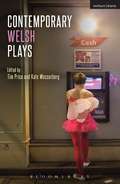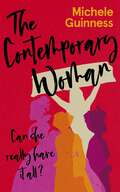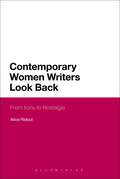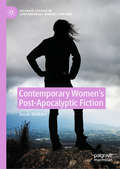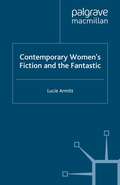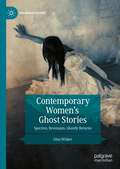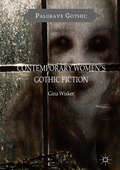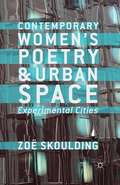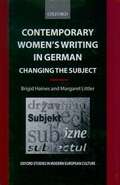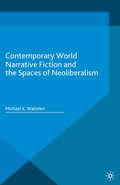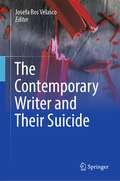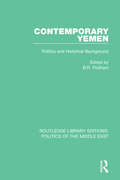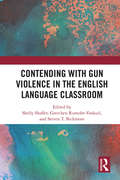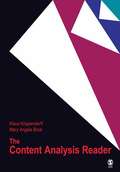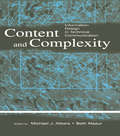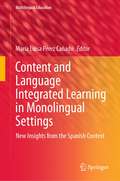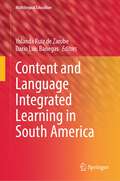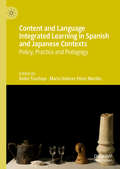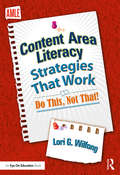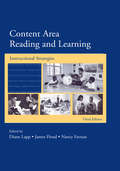- Table View
- List View
Contemporary Welsh Plays: Tonypandemonium, The Radicalisation of Bradley Manning, Gardening: For the Unfulfilled and Alienated, Llwyth (in Welsh), Parallel Lines, Bruised (Play Anthologies)
by Matthew Trevannion Rachel Trezise Tim Price Kate Wasserberg Dafydd James Katherine Chandler Brad BirchRecent years have seen an explosion of new Welsh writing for the stage. With the advent of Theatr Genedlaethol Cymru in 2003 and the launch of National Theatre Wales in 2009, there has been a tectonic shift in Welsh theatre and its perception. Wales has famously celebrated its poets and novelists, but in the twenty-first century, it is the playwright asking the crucial questions. Never before have there been so many playwrights of all ages, from across Wales, finding the stage to be the home for their stories.This collection is the first to officially recognise this new wave of Welsh playwrights. It showcases a wide range of forms, themes and political concerns, as well as representing the most exciting voices at the forefront of Welsh drama, taking the temperature on what be considered to be the first golden age of Welsh playwriting.Tonypandemonium by Rachel Trezise The Radicalisation of Bradley Manning by Tim PriceGardening for the Unfulfilled and Alienated by Brad BirchLlwyth by Dafydd James (published in Welsh) Parallel Lines by Katherine ChandlerBruised by Matthew TrevannionFeatured in the volume are the following plays, along with a foreword by Professor David Ian Rabey of Aberystwyth University, and an introduction by the editors, Tim Price and Kate Wasserberg.
The Contemporary Woman: Can she really have it all?
by Michele GuinnessAt a time when the status of women is still being debated and challenged, how can women play a leading role in society, the workplace and the church? Michele Guinness has been there and done that - not without opposition and not without compromise. In this all-embracing, honest reflection on womanhood Michele uses her own upbringing in the Jewish community to re-examine the views and counterviews on the role of women throughout the Christian tradition and culture, drawing inspiration from scripture, history and personal experience. The Contemporary Woman celebrates a host of women through the ages - from the great biblical matriarchs to the modern-day trailblazers - who have inherited a passionate determination to pursue God's radical call. Michele will encourage women everywhere, of every age, to follow their hearts, and inspire a new generation to discover what it means to be a woman.
Contemporary Women Writers Look Back: From Irony to Nostalgia
by Alice RidoutLong before John Barth announced in his famous 1967 essay that late 20th-century fiction was 'The Literature of Exhaustion,' authors have been retelling and recycling stories. Barth was, however, right to identify in postmodern fiction a particular self-consciousness about its belatedness at the end of a long literary tradition. This book traces the move in contemporary women's writing from the self-conscious, ironic parodies of postmodernism to the nostalgic and historical turn of the 21st century. It analyses how contemporary women writers deal with their literary inheritances, offering an illuminating and provocative study of contemporary women writers' re-writings of previous texts and stories.Through close readings of novels by key contemporary women writers including Toni Morrison, Doris Lessing, Margaret Atwood, Zadie Smith, Emma Tennant and Helen Fielding, and of the ITV adaptation, Lost in Austen, Alice Ridout examines the politics of parody and nostalgia, exploring the limitations and possibilities of both in the contexts of feminism and postcolonialism.
Contemporary Women's Apocalyptic Writing (Palgrave Studies In Contemporary Women's Writing Ser.)
by S. WatkinsContemporary Women's Apocalyptic Writing highlights contemporary literature's post-millennial fascination with the apocalypse and questions the ways in which texts written by female authors differ from those of their male counterparts. Susan Watkins's fascinating new study sheds light on this comprehensive body of male-authored work as an essentially patriarchal phenomenon, leaning towards notions of conservatism. Female writing, she argues, has shown a tendency instead to connect these systems with the genesis of the apocalypse itself. Bold, informative and comprehensive in structure, Contemporary Women's Apocalyptic Writing is an important book for higher-level students and scholars of contemporary literature and culture.
Contemporary Women’s Fiction and the Fantastic
by L. ArmittThis volume examines a wide variety of the ways in which the fantastic has impacted upon contemporary women's fiction. Some of the issues addressed include: the importance of the cyborg and the spectre to critical and fictional discourses of gender; the interface between the grotesque and contemporary readings of feminist utopianism; the growing similarity between late twentieth-century gothicism and the magical real. The study is based upon the work of fifteen writers and includes novels by Allende, Atwood, Carter, Head, Morrison, Weldon, Winterson and Wittig.
Contemporary Women’s Ghost Stories: Spectres, Revenants, Ghostly Returns (Palgrave Gothic)
by Gina WiskerThis book offers new insights on socially and culturally engaged Gothic ghost stories by twentieth century and contemporary female writers; including Shirley Jackson, Angela Carter, Toni Morrison, Ali Smith, Susan Hill, Catherine Lim, Kate Mosse, Daphne du Maurier, Helen Dunmore, Michele Roberts, and Zheng Cho. Through the ghostly body, possessions and visitations, women’s ghost stories expose links between the political and personal, genocides and domestic tyrannies, providing unceasing reminders of violence and violations. Women, like ghosts, have historically lurked in the background, incarcerated in domestic spaces and roles by familial and hereditary norms. They have been disenfranchised legally and politically, sold on dreams of romance and domesticity. Like unquiet spirits that cannot be silenced, women’s ghost stories speak the unspeakable, revealing these contradictions and oppressions. Wisker’s book demonstrates that in terms of women’s ghost stories, there is much to point the spectral finger at and much to speak out about.
Contemporary Women's Gothic Fiction: Carnival, Hauntings and Vampire Kisses (Palgrave Gothic)
by Gina WiskerThis book revives and revitalises the literary Gothic in the hands of contemporary women writers. It makes a scholarly, lively and convincing case that the Gothic makes horror respectable, and establishes contemporary women’s Gothic fictions in and against traditional Gothic. The book provides new, engaging perspectives on established contemporary women Gothic writers, with a particular focus on Angela Carter, Margaret Atwood and Toni Morrison. It explores how the Gothic is malleable in their hands and is used to demythologise oppressions based on difference in gender and ethnicity. The study presents new Gothic work and new nuances, critiques of dangerous complacency and radical questionings of what is safe and conformist in works as diverse as Twilight (Stephenie Meyer) and A Girl Walks Home Alone (Ana Lily Amirpur), as well as by Anne Rice and Poppy Brite. It also introduces and critically explores postcolonial, vampire and neohistorical Gothic and women’s ghost stories.
Contemporary Women's Poetry and Urban Space: Experimental Cities
by Z. SkouldingThis book focuses on the role of the city, and its processes of mutual transformation, in poetry by experimental women writers. Readings of their work are placed in the context of theories of urban space, while new visions of the contemporary city and its global relationships are drawn from their innovations in language and form.
Contemporary Women's Writing in German: Changing the Subject (Oxford Studies In Modern European Culture)
by Brigid Haines Margaret LittlerSix key texts by contemporary women writers are read afresh by leading critics, using insights from poststructuralist and new materialist feminist theory. Ingeborg Bachmann, Christa Wolf, and Elfriede Jelinek have long been prominent in the fields of Austrian modernism, GDR writing, and avant-garde Austrian literature. The innovative work of Anne Duden, Herta Müller, and Emine Sevgi Özdamar sets out to challenge dominant models of German identity. Focusing on the body and suffering, they explore textual representations of trauma, national identity, and displacement. Haines and Littler's readings of these distinguished and complex female authors offer new avenues for discussion. Both critics and their subjects cast a sceptical eye over existing notions of subjectivity in relation to language, gender, and race. Together, they spark controversy and comment, in an increasingly important debate.
Contemporary World Narrative Fiction and the Spaces of Neoliberalism (New Comparisons in World Literature)
by Michael K. WalonenThis book is a transnational study of how contemporary fiction writers from the United States and Canada to Nigeria to India to Dubai have conceptualized the emergent social spaces of the diverse corners of the neoliberal world system. Over the span of the past three to four decades, free market economic policies have been sold to or pushed upon every society on the globe in some way, shape, or form. The upshot of this has been a world system structured in terms of a vast shift of power and resources from government to private enterprise, dwindling civic life replaced by rising consumerism, an emerging oligarchic rentier class, large segments of population faced with meager material conditions of existence and few prospects of socio-economic mobility, and a looming sense of a near future dominated by further economic collapses and mounting social strife. This book analyses a wide cultural array of some of the most poignant narrative engagements with neoliberalism in its various localized manifestations throughout the world.
The Contemporary Writer and Their Suicide
by Josefa Ros VelascoThis volume is the continuation of the book Suicide in Modern Literature, edited by Josefa Ros Velasco. Considering the positive reception of this book, Ros Velasco launches the second part, entitled The Contemporary Writer and their Suicide. This time, leading representatives of various disciplines analyze the literary, philosophical, and biographical works of contemporary writers worldwide who attempted to commit suicide or achieved their goal, looking for covert and overt clues about their intentions in their writings. This book aims to continue shedding light on the social and structural causes that lead to suicide and on the suicidal mind, but also to show that people assiduous to writing usually reflect their intentions to commit suicide in their writings, to explain how these frequently veiled intentions can be revealed and interpreted, and to highlight the potential of artistic, philosophical, and autobiographical writing as a tool to detect suicidal ideation and prevent its consummation in vulnerable people. This book analyzes several case studies and their allusions to their contexts and the socio-structural and environmental violence and pressures they suffered, expressions of their will and agency, feelings of dislocation between the individual, reality, and existential alienation, and literary styles, writing techniques, and metaphorical language.
Contemporary Yemen: Politics and Historical Background
by B. R. PridhamThis book presents some papers presented to a symposium on contemporary Yemen held in July 1983 by Exeter University's Centre for Arab Gulf Studies in collaboration with the Universities of Aden and San'a', and deals with history, internal and international politics, and administrative subjects.
Contemporary Yemen: Politics and Historical Background
by B. R. PridhamThis book presents some papers presented to a symposium on contemporary Yemen held in July 1983 by Exeter University's Centre for Arab Gulf Studies in collaboration with the Universities of Aden and San'a', and deals with history, internal and international politics, and administrative subjects.
Contending with Gun Violence in the English Language Classroom
by Shelly Shaffer Gretchen Rumohr-Voskuil Steven T. BickmoreUtilizing experiences and expertise from English educators, young adult literature authors, classroom teachers, and mental health professionals, this book considers how secondary English Language Arts can address school gun violence. Curated by field experts, contributions to this volume pay special attention to how a school’s culture and climate affect how teachers and students communicate around difficult topics that are embedded in the curriculum, but not directly addressed. As the first book that helps teachers and teacher educators to grapple with the topic of school violence specifically in the English education classroom, this book promotes young adult literature and writing activities that address timely and unfortunately recurring events.
Contending with Gun Violence in the English Language Classroom
by Shelly Shaffer Gretchen Rumohr-Voskuil Steven T. BickmoreUtilizing experiences and expertise from English educators, young adult literature authors, classroom teachers, and mental health professionals, this book considers how secondary English Language Arts can address school gun violence. Curated by field experts, contributions to this volume pay special attention to how a school’s culture and climate affect how teachers and students communicate around difficult topics that are embedded in the curriculum, but not directly addressed. As the first book that helps teachers and teacher educators to grapple with the topic of school violence specifically in the English education classroom, this book promotes young adult literature and writing activities that address timely and unfortunately recurring events.
The Content Analysis Reader
by Klaus Krippendorff Mary Angela BockPresenting a collection of studies that exemplify what content analysts do and how they solve problems in applying this methodology, this book offers readers additional insights into designing and conducting their own research. It enables readers to learn the process of conducting content analysis research whether used as a companion to Krippendorff′s Content Analysis text, as a supplemental text for content analysis courses, or as an introduction to content analysis by examples.
Content and Complexity: information Design in Technical Communication
by Michael J. Albers Beth MazurInformation design is an emerging area in technical communication, garnering increased attention in recent times as more information is presented through both old and new media. In this volume, editors Michael J. Albers and Beth Mazur bring together scholars and practitioners to explore the issues facing those in this exciting new field. Treating information as it applies to technical communication, with a special emphasis on computer-centric industries, this volume delves into the role of information design in assisting with concepts, such as usability, documenting procedures, and designing for users. Influential members in the technical communication field examine such issues as the application of information design in structuring technical material; innovative ways of integrating information design within development methodologies and social aspects of the workplace; and theoretical approaches that include a practical application of information design, emphasizing the intersection of information design theories and workplace reality. This collection approaches information design from the language-based technical communication side, emphasizing the role of content as it relates to complexity in information design. As such, it treats as paramount the rhetorical and contextual strategies required for the effective design and transmission of information. Content and Complexity: Information Design in Technical Communication explores both theoretical perspectives, as well as the practicalities of information design in areas relevant to technical communicators. This integration of theoretical and applied components make it a practical resource for students, educators, academic researchers, and practitioners in the technical communication and information design fields.
Content and Complexity: information Design in Technical Communication
by Michael J. Albers Mary Beth MazurInformation design is an emerging area in technical communication, garnering increased attention in recent times as more information is presented through both old and new media. In this volume, editors Michael J. Albers and Beth Mazur bring together scholars and practitioners to explore the issues facing those in this exciting new field. Treating information as it applies to technical communication, with a special emphasis on computer-centric industries, this volume delves into the role of information design in assisting with concepts, such as usability, documenting procedures, and designing for users. Influential members in the technical communication field examine such issues as the application of information design in structuring technical material; innovative ways of integrating information design within development methodologies and social aspects of the workplace; and theoretical approaches that include a practical application of information design, emphasizing the intersection of information design theories and workplace reality. This collection approaches information design from the language-based technical communication side, emphasizing the role of content as it relates to complexity in information design. As such, it treats as paramount the rhetorical and contextual strategies required for the effective design and transmission of information. Content and Complexity: Information Design in Technical Communication explores both theoretical perspectives, as well as the practicalities of information design in areas relevant to technical communicators. This integration of theoretical and applied components make it a practical resource for students, educators, academic researchers, and practitioners in the technical communication and information design fields.
Content and Language Integrated Learning in Monolingual Settings: New Insights from the Spanish Context (Multilingual Education #38)
by María Luisa Pérez CañadoThis book offers new empirical insights into the current state of Content and Language Integrated Learning (CLIL) characterisation (through an innovative proposal to link CLIL to English as a Lingua Franca), implementation (via observation protocols and SWOT analyses), and research (by examining the effects of CLIL on the L1, foreign language, key competences, and content subjects taught through English). The book provides a state of the art of the CLIL arena, identifies the chief challenges that need to be addressed and signposts possible ways of overcoming these in order to continue advancing smoothly into the next decade of CLIL development. This book will be of interest to researchers, policy-makers, educational authorities, and practitioners as it will assist them in making informed decisions about how to characterise, implement, and investigate CLIL in the bi- and plurilingual programs that are more frequently introduced in monolingual contexts.
Content and Language Integrated Learning in South America (Multilingual Education #46)
by Yolanda Ruiz de Zarobe Darío Luis BanegasCLIL is a pedagogical approach which has gained traction in different educational and geographical contexts as a key tool in language learning and teaching. After more than 25 years of implementation, we can assert that we have learned a great deal about what CLIL entails. However, it is also true that we still need to contextualise the approach in order to clearly delimit what CLIL has to offer in each setting. This is precisely the aim of this book. This volume focuses on CLIL in South American contexts. It identifies, clarifies and offers insights into issues related to its characterisation and implementation, as well as teacher education. With contributions from a prestigious array of scholars and practitioners from various parts of South America, it also highlights some of the achievements and challenges in the process of implementing CLIL in the region. Against the backdrop of South American contexts, this book aims to provide a useful and innovative lens through which policy makers, researchers and teachers will find significant implications for the development of CLIL.
Content and Language Integrated Learning in Spanish and Japanese Contexts: Policy, Practice and Pedagogy
by Keiko Tsuchiya María Dolores Pérez MurilloThis edited book compiles pedagogical practices and studies of Content and Language Integrated Learning (CLIL) from two sites: Spain, where CLIL has been widely implemented for more than a decade, and Japan, where the CLIL approach is still in its relative infancy, and quickly gaining momentum. Focusing on three aspects of the CLIL implementations: policy, practice and pedagogy, the authors describe how CLIL has evolved in distinctive socio-political, historical and cultural contexts. The chapters range across primary, secondary and tertiary education, and examine English language teaching and learning at both the macro level - through language education policy - and the micro level - with a focus on classroom interaction and pedagogy. This book fills a gap in the English as a Medium of Instruction (EMI) literature, and will be of particular interest to language teachers, teacher trainers, and students and scholars of applied linguistics more broadly.
Content Area Literacy Strategies That Work: Do This, Not That!
by Lori G. WilfongContent area teachers are now being tasked with incorporating reading and writing instruction, but what works? In this essential book from Routledge and AMLE, author Lori G. Wilfong describes ten best practices for content area literacy and how to implement them in the middle-level classroom. She also points out practices that should be avoided, helping you figure out which ideas to ditch and which to embrace. Topics covered include… Building background knowledge quickly Using specific strategies to scaffold focus while reading Using small group reading strategies to bring personal response and accountability to the content Understanding items that make reading in different disciplines unique Teaching content area vocabulary in meaningful ways Making writing an authentic process through daily and weekly assignments Planning and teaching effective informational and argumentative pieces Each chapter includes Common Core connections and practical templates and tools. The templates are available as free eResources so you can easily print them for classroom use.
Content Area Literacy Strategies That Work: Do This, Not That!
by Lori G. WilfongContent area teachers are now being tasked with incorporating reading and writing instruction, but what works? In this essential book from Routledge and AMLE, author Lori G. Wilfong describes ten best practices for content area literacy and how to implement them in the middle-level classroom. She also points out practices that should be avoided, helping you figure out which ideas to ditch and which to embrace. Topics covered include… Building background knowledge quickly Using specific strategies to scaffold focus while reading Using small group reading strategies to bring personal response and accountability to the content Understanding items that make reading in different disciplines unique Teaching content area vocabulary in meaningful ways Making writing an authentic process through daily and weekly assignments Planning and teaching effective informational and argumentative pieces Each chapter includes Common Core connections and practical templates and tools. The templates are available as free eResources so you can easily print them for classroom use.
Content Area Reading and Learning: Instructional Strategies, 3rd Edition
by James Flood Diane Lapp Nancy FarnanHow can teachers make content-area learning more accessible to their students? This text addresses instructional issues and provides a wealth of classroom strategies to help all middle and secondary teachers effectively enable their students to develop both content concepts and strategies for continued learning. The goal is to help teachers model, through excellent instruction, the importance of lifelong content-area learning. This working textbook provides students maximum interaction with the information, strategies, and examples presented in each chapter. This book is organized around five themes: Content Area Reading: An Overview The Teacher and the Text The Students The Instructional Program School Culture and Environment in Middle and High School Classrooms. Pedagogical features in each chapter include: a graphic organizer; a chapter overview, Think Before, Think While and Think After Reading Activities - which are designed to integrate students’ previous knowledge and experience with their new learnings about issues related to content area reading, literacy, and learning, and to serve as catalysts for thinking and discussions.This textbook is intended as a primary text for courses on middle and high school content area literacy and learning.
Content Area Reading and Learning: Instructional Strategies, 3rd Edition
by James Flood Diane Lapp Nancy FarnanHow can teachers make content-area learning more accessible to their students? This text addresses instructional issues and provides a wealth of classroom strategies to help all middle and secondary teachers effectively enable their students to develop both content concepts and strategies for continued learning. The goal is to help teachers model, through excellent instruction, the importance of lifelong content-area learning. This working textbook provides students maximum interaction with the information, strategies, and examples presented in each chapter. This book is organized around five themes: Content Area Reading: An Overview The Teacher and the Text The Students The Instructional Program School Culture and Environment in Middle and High School Classrooms. Pedagogical features in each chapter include: a graphic organizer; a chapter overview, Think Before, Think While and Think After Reading Activities - which are designed to integrate students’ previous knowledge and experience with their new learnings about issues related to content area reading, literacy, and learning, and to serve as catalysts for thinking and discussions.This textbook is intended as a primary text for courses on middle and high school content area literacy and learning.
